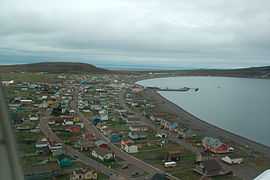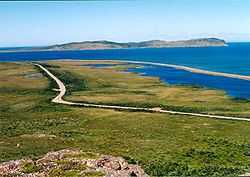Miquelon-Langlade
| Miquelon-Langlade | |
|---|---|
 | |
 | |
| Coordinates: 47°06′00″N 56°22′45″W / 47.100000°N 56.3792°WCoordinates: 47°06′00″N 56°22′45″W / 47.100000°N 56.3792°W | |
| Country | France |
| Overseas collectivity | Saint Pierre and Miquelon |
| Government | |
| • Mayor | Stéphane Coste |
| Area | |
| • Land | 205 km2 (79 sq mi) |
| Population (January 2006 census) | |
| • Population1 | 616 |
| • Population1 Density | 3.0/km2 (7.8/sq mi) |
| INSEE/Postal code | 97501 / 97500 |
| Elevation | 0–240 m (0–787 ft) |
| 1 Population without double counting: residents of multiple communes (e.g., students and military personnel) only counted once. | |
Miquelon-Langlade is the larger and less populated of the two communes (municipalities) making up the French overseas collectivity of Saint Pierre and Miquelon, located to the south of Newfoundland in the Atlantic Ocean. It consists of three geological islands: Miquelon, Langlade and Le Cap, connected with tombolos (sand dunes). The communal seat is the settlement of Miquelon, on the northern tip, where the entire island's permanent population of 616 is located. Miquelon Airport provides flights to Montreal and to nearby Saint-Pierre.
Geography


Located in the North Atlantic, west of Newfoundland's Burin Peninsula, Miquelon-Langlade covers a total land area of 205 square kilometres (79 sq mi). It is made up of three geologically distinct islands bound together by tombolos—long strips of sand dune— Le Cap in the north, Miquelon (Grand Miquelon) in the center and Langlade (Petite Miquelon) in the south.
On the south of the Miquelon Island is a large lagoon known as the Grand Barachois which is host to a large population of seals and other wildlife. Miquelon is also a well known destination for bird watching.
8 miles (13 km) long tombolo sandspit called La Dune encloses the Grand Barachois.[1] In the 18th century it was still possible to sail a boat between Miquelon and Langlade, but by the end of that century La Dune had closed in to form an isthmus between the islands.[2]
Located at 3 mi (4.8 km) west of Saint Pierre Island, Langlade is an ancient peneplain drained by numerous short rivers, including the Belle, the largest, which flows to the northwest.[3] The coast of Langlade is lined with steep cliffs, except to the northwest.
Climate
Köppen-Geiger climate classification system classifies its climate as subarctic (Dfc).[4] Summers are mild while winters are cold. It receives precipitation all the year.
| Climate data for Miquelon-Langlade | |||||||||||||
|---|---|---|---|---|---|---|---|---|---|---|---|---|---|
| Month | Jan | Feb | Mar | Apr | May | Jun | Jul | Aug | Sep | Oct | Nov | Dec | Year |
| Average high °C (°F) | −0.1 (31.8) |
−0.6 (30.9) |
1.5 (34.7) |
5.3 (41.5) |
9.7 (49.5) |
13.7 (56.7) |
17.9 (64.2) |
19.3 (66.7) |
16.5 (61.7) |
11.5 (52.7) |
7.1 (44.8) |
2.2 (36) |
8.67 (47.6) |
| Daily mean °C (°F) | −3.5 (25.7) |
−4.2 (24.4) |
−1.7 (28.9) |
2 (36) |
5.7 (42.3) |
9.6 (49.3) |
13.9 (57) |
15.4 (59.7) |
12.5 (54.5) |
7.8 (46) |
4 (39) |
−0.8 (30.6) |
5.06 (41.12) |
| Average low °C (°F) | −6.8 (19.8) |
−7.7 (18.1) |
−4.9 (23.2) |
−1.2 (29.8) |
1.8 (35.2) |
5.6 (42.1) |
10 (50) |
11.6 (52.9) |
8.5 (47.3) |
4.1 (39.4) |
0.9 (33.6) |
−3.8 (25.2) |
1.51 (34.72) |
| Precipitation mm (inches) | 124 (4.88) |
106 (4.17) |
101 (3.98) |
102 (4.02) |
101 (3.98) |
105 (4.13) |
98 (3.86) |
109 (4.29) |
118 (4.65) |
137 (5.39) |
137 (5.39) |
132 (5.2) |
1,370 (53.94) |
| Avg. rainy days (≥ 1 mm) | 8 | 6 | 5 | 6 | 7 | 6 | 7 | 5 | 6 | 9 | 9 | 10 | 84 |
| Source #1: Climate-Data.org (altitude: 1m)[4] | |||||||||||||
| Source #2: Storm247.com for rainy days[5] | |||||||||||||
History
The name Miquelon is of Basque origin and means "Michael", as several fishermen with this name were established in the island. In 1579, the names Micquetõ, Micquelle appeared for the first time in Martin de Hoyarçabal's navigational pilot. The name evolved over time into Miclon, Micklon, and finally Miquelon.
Demographics
The capital of the commune, Miquelon, is located on the north, along a tombolo that connects the formerly separate island of Le Cap with the northwestern part of Miquelon Island. It lies north of a barachois and has constructed a small harbour protected with breakwaters along the eastern side of the isthmus. Miquelon is home to the Miquelon Airport. The Centre Médical de Miquelon has some medical care facilities for residents, but other facilities are available on Saint Pierre Island as well as in St. John's, Newfoundland and Labrador.
The population of Miquelon-Langlade is mainly of Basque and Acadian ancestry. The population of Miquelon-Langlade was 616 at the January 2006 local census, 615 of whom lived on Miquelon.
Transportation
Miquelon can be reached by boat or by plane from Saint-Pierre and is served by Miquelon Airport which is located adjacent to the settlement of Miquelon. The airport is served by Air Saint-Pierre with flights both to Saint Pierre Airport and Canada.
See also
References
- ↑ Transport Miquelonnais
- ↑ "Transport Miquelonnais - Geographical situation". Retrieved 2010-06-12.
- ↑ Saint Pierre & Miquelon. Territorial Collectivity of France, in the North America
- ↑ 4.0 4.1 "Climate: Miquelon-Langlade - Climate graph, Temperature graph, Climate table". Climate-Data.org. Retrieved 2013-12-10.
- ↑ "Commune de Miquelon-Langlade in Saint-Pierre-et-Miquelon, Saint Pierre and Miquelon - Climate". Storm247.com. Retrieved 2013-12-10.
External links
| Wikimedia Commons has media related to Miquelon-Langlade. |
| Wikivoyage has a travel guide for Miquelon. |
- Tourism and Travel Resources for St Pierre & Miquelon
- Frequently Asked Questions Tourism and Travel
- Map of Miquelon
- Le Phare: Association of Tourism Professionals
- Local Airline Air Saint-Pierre
- Ferry service for Saint-Pierre, Miquelon and Fortune Newfoundland
- 2012 French Presidential Election